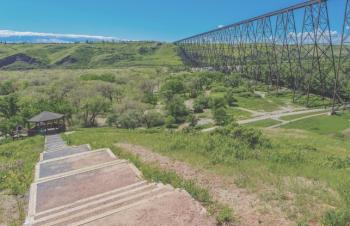Image Caption
Summary
Local Journalism Initiative Reporter
Windspeaker.com
QUEST Canada is working with communities across Canada to reduce greenhouse gas emissions with the Net-Zero Communities Accelerator Program (NCA).
The goal is to provide communities with the tools and training that will increase the efficiency of their systems while reaching a net-zero emissions goal by 2050.
“It started off in New Brunswick (New Brunswick Smart Energy Communities Accelerator) and we’ve had huge success working with different communities and municipalities and the First Nations communities,” said Omar Farag, projects senior lead for QUEST.
“We thought it would be a good idea to expand it and the Prairies Cohort is the second phase of that project.”
Ten communities will participate in the NCA facilitated through QUEST Canada and its partners, including the Centre for Indigenous Environmental Resources, the Community Energy Association, Eco-Oest Canada/Eco-West Canada and the Municipal Climate Change Action Centre.
The Prairies Cohort includes the Sandy Bay Ojibway First Nation, the St. Theresa Point First Nation and the community of De Salaberry in Manitoba. The towns of Biggar and Gravelbourg are the only centres in Saskatchewan involved. St. Albert, Pincher Creek, Lethbridge, Medicine Hat and Devon, all in Alberta, are also included.
“It’ll make a local environmental and economic impact and really co-create solutions with these communities to get to net-zero quicker and make brands that are durable for the long haul,” said Seth Leon, program manager.
“These are communities that want to be, let’s say, ahead of the game when it comes to their energy.”
Each community will be provided with a variety of training in the areas of energy efficiency, emissions, resilience planning and implementation to increase renewable energy use.
“What we do is we basically have huge streams within this program,” said Farag. “One is a project initiation stream and the other is capacity building.”
If a community is already on its net-zero journey and has already established strategies, then it will be placed in the project initiation stream, whereas if it is just starting out it will be placed in the capacity-building stream.
Whichever stream they are currently in, each of the communities will be connected with experts, peers and funding opportunities to support their goals.
There is a slightly different approach taken for First Nations as compared to municipalities, said Farag.
The municipalities will go through a benchmarking tool, which “gauges where the community is at so it gives the community a score in different criteria and, based on that after we’ve done all the work with them, we will re-benchmark the community and see how much they’ve improved,” Farag said.
The Indigenous communities will not go through benchmarking, but instead work will be based on the overall community energy need.
“It’s kind of more of a, I’d say, like more of a storytelling approach versus a numbers approach. So, we’ll sit down with different demographics within the community and talk to them about energy.”
Each community will progress for two or three years and then it will be reevaluated to assess progress and provided a community energy and emissions plan to allow each to replicate the exercises into the future.
Leon said the program will have positive impacts on more than controlling a community’s emissions. It will also have benefits that include control of local dollars currently used to pay energy bills, and the creation of local job opportunities.
“(It’s) really trying to put the community in the driver’s seat,” said Leon.
“It’s important for this work, in general around getting to net-zero, for Indigenous communities to be at the forefront of this. The challenge of getting to net-zero is going to look different in Indigenous communities just given issues of remote(ness) and aspects that way. But, at the same time, I think there’s a lot of local leadership and local knowledge to create plans that will be custom built to be successful in those communities… It’s really about working together for a plan that’s going to be durable.”
To learn more about the Quest Canada program go to https://questcanada.org/
Windspeaker is owned and operated by the Aboriginal Multi-Media Society of Alberta, an independent, not-for-profit communications organization.
Each year, Windspeaker.com publishes hundreds of free articles focused on Indigenous peoples, their issues and concerns, and the work they are undertaking to build a better future.
If you support objective, mature and balanced coverage of news relevant to Indigenous peoples, please consider supporting our work. Whatever the amount, it helps keep us going.

